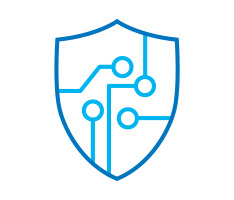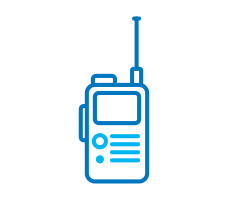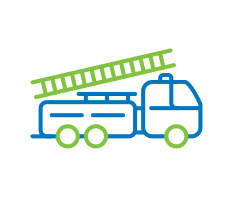Wildfire Resiliency
A wise investment in preparedness
Avista is committed to keeping people and property safe. So, we are expanding our current safeguards for preventing, mitigating and reducing the impact of wildfires with a new enhanced 10-year Wildfire Resiliency Plan.
View the 2024 Wildfire Resiliency Plan
View the 2023 Wildfire Resiliency Plan
View the 2020 Wildfire Resiliency Plan
Guarding against growing risks
The risk of wildfires is increasing in our region. Above-normal fire seasons have repeated since 2000. Residential development is also quickly expanding into forested areas and other higher fire-risk locations. Avista’s enhanced Wildfire Resiliency Plan will further minimize the possibilities of wildfires and their related service disruptions.
An overview of the plan
The plan was developed through a series of internal workshops and industry research along with collaboration with state and local fire and land management agencies. It focuses on:

Grid hardening
Replace and/or strengthen electric infrastructure, especially in fire-prone areas, to protect it from possible damage and reduce the likelihood of spark-ignition sources.
- Install a special fire-retardant wire mesh around the bottom of wood transmission poles located in low vegetation and high fire threat areas. Chemically reactive to heat, this mesh protects against ground fires, strengthens the pole and does not require continual maintenance like the fire-resistant paint historically used.
- Require all new transmission line construction to incorporate steel poles, as steel is more resistant to fire, severe weather (such as high winds) and damage caused by humans and animals.
- Accelerate our replacement of aging-wood poles with new steel poles. (Avista has been working to replace poles along 2,270 miles of transmission lines since 2006.)
- Replace wooden crossarms on poles with fiberglass crossarms in high-risk fire areas.
- Phase out polymer insulators on transmission lines in favor of strengthened, noncombustible glass insulators.
- Enhance transmission line inspections, including with aerial surveys, by considering additional risk factors such as nearby wood debris, adjacent logging and construction activities, and other possible hazards.

Vegetation management
Elevate our already robust management of fire-prone areas, especially near densely population locations, to further reduce the possibility of contact between vegetation and power lines.
- Complete more frequent analyses of the entire system (annually) to identify vegetation encroachment more quickly. Trees are the number one source of utility-related fire ignitions.
- Accelerate the removal of dead and dying trees. On average, 2,600 risk trees are removed each year from Avista’s transmission system and 15,500 from its distribution system.
- Continue routine tree-trimming near power lines with added coordination from public and private landowners.
- Maintain regular field and ground inspections on foot.
- Introduce aerial surveys using LIDAR (light detection and ranging) and satellite to digitally identify tree/vegetation encroachments on power lines, detect thermal hot spots and complete real-time inspections of trees and infrastructure.
- Increase the use of herbicides in fire-prone areas to prevent growth of problem vegetation.
- Identify opportunities and work with key stakeholders to expand the areas around power lines that Avista is responsible for maintaining. Expanding right-of-ways will allow us to manage problem vegetation more effectively.
- Watch vegetation management video.

Situational awareness
Improve operational decisions by increasing our ability to assess potential fire risks.
- Leverage existing systems that monitor, communicate with, and remotely control the power grid to help us prevent and/or more quickly respond to wildfires. These systems include Transmission SCADA (supervisory control and data acquisition), Distribution DMS (distribution management system), and AMI (automated meter infrastructure).
- Develop new dashboard technology to enhance fire-risk assessment through weather forecasting. This information is vital to adapting operations and coordinating with local fire protection agencies in times of extreme weather events that could cause a wildfire.
- Use our Wildland Urban Interface (WUI) to map and prioritize areas where high human population and development is near forested areas and exposed to fire risk.
- Coordinate more closely with fire protection agencies during extreme weather events.
- Watch fire safety mode video.

Operations and emergency response
Decrease the potential for wildfires by instigating operational changes when re-energizing power lines in rural and or forested areas.
- Begin physically patrolling outage areas during certain hot, dry and windy conditions to mitigate the risk of sparks before re-energizing a line. This requires more time to restore service, especially if there has been a fire, as fire officials decide when our crews can enter a fire zone to begin work.
- Continue to automatically re-energize a line following a fault, or tripped utility breaker, but only when conditions are normal. (The grid immediately tests a faulted circuit before re-energizing it.)
- Incorporate advanced training and event simulation to better prepare Avista personnel to work with fire professionals during a wildfire event.

Worker and public safety
Increase overall safety by creating cohesive partnerships with emergency first responders and fire agencies to share wildfire responsibilities.
- Prioritize employee and public safety over customer restoration.
- Provide Avista’s 550 electric line workers (already trained as emergency responders) with basic fire training taught by a fire agency professional prior to the fire season (April-May).
- Embed Avista field personnel into the Fire Service Incident Command System (controls and coordinates emergency response from multiple agencies) to act as a liaison between Avista and the ICS fire commander.
- Launch an Expedited Response pilot program in partnership with Spokane County Fire Districts and other fire districts in which Avista will initiate a 911 call whenever an isolated transmission fault occurs during fire season. This will help fire fighters more quickly investigate and extinguish a possible fire before it can spread.
- Use performance metrics to adjust and align planned future actions.
- Regularly engage with other regional utilities, task forces and utility commissions to leverage and exchange best practices.


